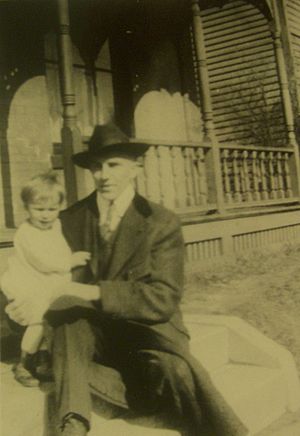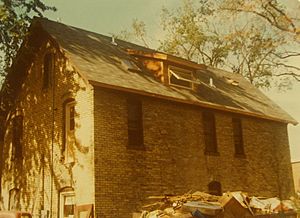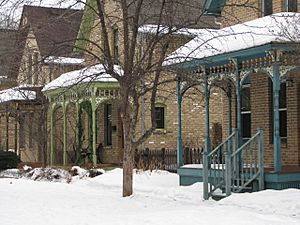Milwaukee Avenue Historic District facts for kids
Quick facts for kids |
|
|
Milwaukee Avenue Historic District
|
|

Four houses within the Milwaukee Avenue Historic District
|
|
| Location | Minneapolis, Minnesota |
|---|---|
| Built | 1885 |
| Architect | Ragan, William |
| Architectural style | Common Man's Architecture |
| NRHP reference No. | 74001021 |
| Added to NRHP | May 2, 1974 |
The Milwaukee Avenue Historic District is a special area in the Seward neighborhood of Minneapolis. It has two city blocks of small homes. These houses were built between 1884 and 1890. A man named William Ragan, who bought and sold land in Minneapolis, built them.
The houses were made for people who did not earn a lot of money. Over time, they started to fall apart. By the 1970s, there were plans to tear them down. But a group of people living there and other concerned citizens worked hard to save the houses. Because of their efforts, the houses were added to the National Register of Historic Places. This helped protect them and get them fixed up. Today, cars are not allowed on Milwaukee Avenue. It is a friendly place for bikes and people walking.
How Milwaukee Avenue Began
In the late 1800s, Minneapolis was growing very fast. Many people were moving to the city. There was a big need for affordable homes, especially for new immigrants.
The street was first planned as an alley. But William Ragan turned it into a street. He called it 22½ Avenue. The houses were built very close together on narrow pieces of land. They had tiny side yards and no front yards. This made them look a bit like rowhouses. Most houses were made with brick on the outside and wood frames inside. They all had similar roof shapes and front porches.
The street kept its '½' in its name until 1906. People living there asked the Minneapolis City Council to change the name. They felt that '½' made it sound like they lived in an alley. The street's name was changed to Milwaukee Avenue. No one knows for sure why this name was chosen. It might be because it was close to the Milwaukee Short Line Railroad.
Saving the Homes
After World War II, the houses on Milwaukee Avenue were in bad shape. They had not been taken care of during the Great Depression and the war years. In 1959, the City of Minneapolis made a plan for the Seward neighborhood. This plan said the Milwaukee Avenue houses were "deteriorated." This meant they had no indoor plumbing or were very damaged.
In other neighborhoods, the City had fixed up areas without asking the public. This often made the areas more expensive. But the people on Milwaukee Avenue were different. They were not very rich, but they were good at protesting. Many had protested the Vietnam War. By 1970, the City planned to tear down the Milwaukee Avenue houses. They would use money from a government program called Housing and Urban Development (HUD).
The people living on Milwaukee Avenue and nearby formed a group. They called it the Seward West Project Area Committee (PAC). Their goal was to save the homes. They said the houses were important to history and should be kept. The City argued that fixing the houses would cost more than building new ones.
The City continued with its plan and did not listen to the PAC. So, the PAC secretly applied to have the Milwaukee Avenue district added to the National Register of Historic Places. Their application was approved on May 2, 1974. This was a big win! It meant the City could not change or destroy the houses using federal money without a public meeting.
Nine of the Milwaukee Avenue houses were too damaged to save. They had to be torn down. One other house was moved to a different spot. In the empty spaces, new townhomes were built. They were made to look like the original houses. The other houses got new indoor plumbing, new basements, and better woodwork and porches. Also, a special path for people was built down the middle of Milwaukee Avenue. It replaced a one-way street. Now, the Avenue is great for bikes and walking, and cars are not allowed.
Milwaukee Avenue Today
Milwaukee Avenue is still a special place today. In 2007, people celebrated 30 years since the houses were saved and fixed up. They offered tours of eight of the homes. People could walk around and see inside.
The houses were also shown on a local TV show called Finding Minnesota in 2005. The short video showed interviews with someone who lived on Milwaukee Avenue. It also featured Bob Roscoe, an activist who helped save the street.






